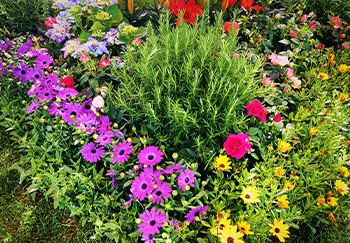10 Drought Resistant Plants for British Gardens
June 16th, 2023 | Categories
As our summers become hotter and drier generally, water becomes an ever more precious resource. Regions in the UK – especially the south – are enacting hosepipe bans more often as a result, and that puts much stress on our gardens, from the lawn to the plants, trees, and shrubs we love and have cared for. Many gardeners are now adapting and thinking about plants that can tolerate such periods of prolonged heat while still giving us visual interest and scents to enjoy, as well as being attractive to wildlife. Native Mediterranean plants in particular – which evolved in dry soils with little rainfall – are the perfect choice and are growing in popularity, though some have always been very popular, like lavender for example.
10 Popular Drought Tolerant Plants
Below is our list of plants that are drought tolerant but offer interest to the garden whether it be colour, scent, or attracting nature – or everything! Some you may recognise, some you might not have thought of before, all wonderful additions to the garden whatever type of gardener you are.
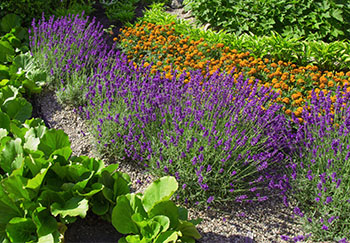
Lavender
Well-known and well-loved, lavender is a beautiful drought tolerant flowering plant with a sweet, calming scent. It’s easy to grow and requires minimal maintenance, making it ideal for beginner gardeners. It’s loved by all manner of pollinators too. Lavender prefers full sun and well-drained soil, so make sure to choose an area with plenty of sunshine and good drainage. Water lavender deeply once or twice per week during periods of drought or when the soil is dry to the touch. Lavender blooms from late spring into early summer, so you’ll have plenty of time to enjoy its fragrant flowers. Varieties like Hidcote and Munstead are very popular.
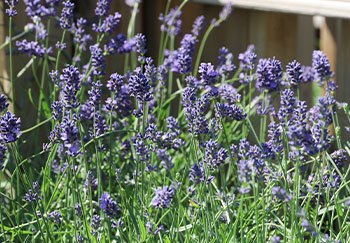
Ceanothus
Ceanothus or Californian Lilac, is a wonderful evergreen shrub with glossy green leaves and an abundance of deep blue flowers that bloom in clusters from late spring through early summer, making it an ideal choice for adding colour to your garden all year round. It’s highly drought tolerant, doesn’t mind a poor soil, and prefers full sun or partial shade in well-drained soil with occasional watering. Avoid over-watering as this can lead to root rot. They can usually get all the water they need from rainfall. This one is perfect for those leaning towards a low-maintenance option.
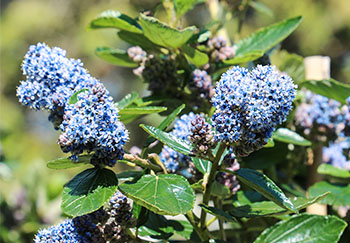
Verbena
Native to South America, Verbena have evolved to be very drought tolerant plants. They thrive in well-drained and even poorer soil types. Depending on the variant, the plant produces tiny clusters of flowers in a variety of colours from bright purple to deep red and pink, on thin stems throughout summer and into early autumn. As you would expect, they also prefer areas where they can get sun for most of the day. They are very attractive to pollinators like butterflies and bees.
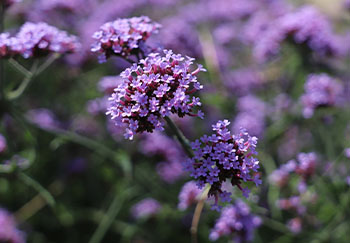
Sedum
Sedum is a succulent plant with thick leaves and colourful flowers that bloom from mid-summer through to autumn. They are perfect for adding colour to your garden when other plants have stopped flowering. Sedum prefers full sun but can tolerate some shade. A good soak is only required once or twice per week during periods of drought or when the soil is dry to the touch. Sedum makes a great ground cover plant as it spreads over time but just be careful not to let it get too large if you don’t want it taking over a wide area of your beds and borders.
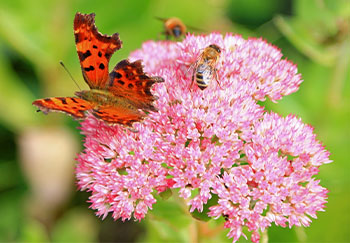
Osteospermum
Osteospermum, commonly known as African Daisy, is an attractive and versatile drought-tolerant plant that has become popular among UK gardeners. The vibrant flowers of Osteospermum are one of the main reasons this plant has gained popularity among gardeners. They resemble daisies in appearance, with a central disc surrounded by radiating petals. The flowering season is long too, usually extending from late spring to early autumn, providing a long-lasting display of colour in the garden. The flowers themselves come in a wide range of colours, including white, pink, purple, yellow, and various shades of blue. The flowers are nectar rich too providing a valuable food source for many beneficial pollinators and insects.
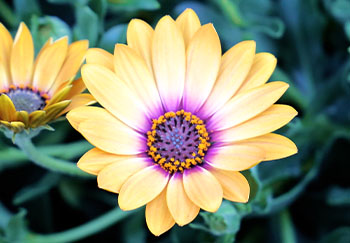
Agapanthus
Agapanthus is a great flowering plant native to South Africa. The plant’s South African origins mean that it is well-adapted to surviving in dry and poor soil conditions, making it perfect for the increasingly warmer and drier UK summers. The plant typically grows relatively high, up to 1.5m and features long, strap-like leaves that create a lush, green backdrop for the stunning flowers. This makes them perfect for the back of borders too where you can place shorter plants in front. The flowers of Agapanthus are stunning and bloom in large, spherical clusters called umbels, which can contain up to 100 individual flowers. The flowering season usually lasts from mid-summer to early autumn, providing a long-lasting burst of colour too. Flowers come in various shades of blue, from pale pastels to deep, vibrant hues. Pollinators absolutely love them too!
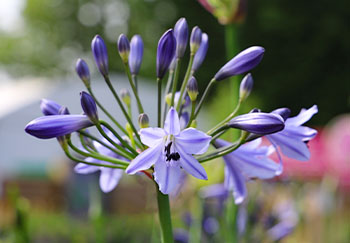
Hardy Geraniums
Hardy geraniums are lovely looking drought-tolerant plants native to various regions, including Europe, Asia, and North America. They have lobed, green leaves that create a beautiful backdrop for their delicate flowers. The flowers themselves are undoubtedly one of the main reasons for their popularity among UK gardeners. They bloom in a variety of shapes, from simple saucer-shaped flowers to more intricate double forms. The flowering season usually extends from late spring to early autumn, providing a long-lasting display of colour in the garden. Once established, watering requirements are low. One thing to note, to keep Geraniums flowering and encourage new growth, they will need to be cut back.
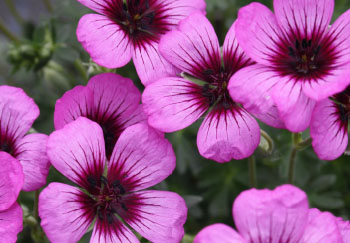
Rosemary
Rosemary is an evergreen shrub that adds fantastic colour and texture to any garden. It’s also incredibly low-maintenance, requiring little more than occasional watering during dry spells. Rosemary prefers full sun and well-drained soil; if you’re planting in containers, make sure they have ample drainage holes. Rosemary is wonderfully fragrant and blooms from late spring through early summer, producing wonderful small blue flowers that attract bees and other pollinators. Being a popular herb, another added bonus is you’ll be able to pick it now and again for culinary uses.
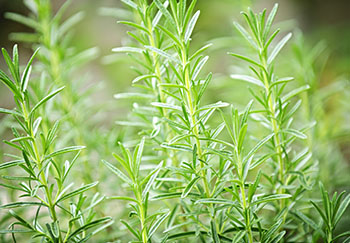
Achillea
Achillea is another great drought-tolerant option with a good flowering season from early summer to early autumn. They are well adapted to low moisture levels and drier soils. Their flowers come in a wide range of colours, including white, yellow, pink, red, and orange. They bloom in dense, flat-topped clusters, which can span up to 15 cm across making them quite visually striking in the garden.
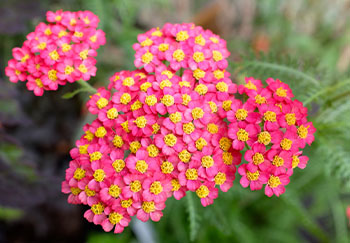
Heuchera
Heuchera, also known as coral bells, is an attractive and versatile plant with stunning foliage, delicate flowers, and drought tolerance. It is an excellent choice for gardens facing increasingly warmer and drier summers in the south of the UK, as they really dislike wet, heavy or very dry soil conditions, as well as deep shade. One of the main reasons for Heuchera’s popularity is its striking foliage, which comes in a wide range of colours, including green, bronze, purple, silver, and even near-black shades. In addition to its foliage, Heuchera also produces delicate, bell-shaped flowers that bloom on slender, upright stems. The flowering season usually extends from late spring to early summer, providing a subtle yet charming display of colour in the garden.
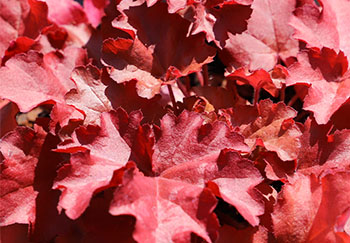
Adapting our Gardens to Changing UK Summers
By incorporating different types of drought tolerant plants as well as our other favourites in our gardens, we can keep them interesting and enjoyable places to sit and gather, while still doing our part for local biodiversity. With the drought-tolerant plants highlighted above, it also means you can still have an attractive, active garden during a hosepipe ban, without fear of losing too many to the stress of persistent sun and heat. As you can see, drought-resistant plants and shrubs are amongst some of the most colourful and attractive garden plants. With so many to choose from, why not incorporate some into your garden this summer? https://bit.ly/3Nb6c62
